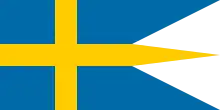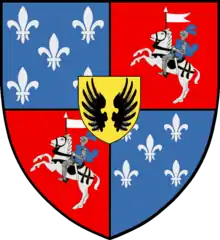Magnus Fredrik Brahe | |
|---|---|
 Portrait by Carl Frederik von Breda. | |
| Lord Marshal of Sweden | |
| In office 1800–1800 | |
| Preceded by | Eric Ruuth |
| Succeeded by | Michael Anckarsvärd |
| Personal details | |
| Born | 15 October 1756 Stockholm, Kingdom of Sweden |
| Died | 12 December 1826 (aged 70) Stockholm, Kingdom of Sweden |
| Resting place | Brahe family crypt, Östra Ryd Church, Uppland |
| Political party | Gustavian Party |
| Spouse(s) |
Ulrica Catharina Koskull
(m. 1779) |
| Parent(s) | Erik Brahe Stina Piper |
| Relatives | Brahe family |
| Residence(s) | Skokloster Castle Rydboholm Castle Spyker Castle Skarhult Castle Salsta Castle |
| Alma mater | Uppsala University |
| Military service | |
| Allegiance | |
| Branch/service | Royal Drabant Corps |
| Rank | Captain lieutenant |
Magnus Fredrik Brahe (15 October 1756 – 12 December 1826) was a Swedish noble and courtier.
Biography
Magnus Fredrik Brahe was born on 15 October 1756 to Count Erik Brahe and his second wife Countess Stina Piper, three months after his father's death. Like his father, he supported absolute monarchical power. During the baptism of Crown Prince Gustav Adolph on 10 November 1778, Brahe was appointed godparent by King Gustav III of Sweden for which he received the Gustav III's Godparent Insignia on 27 December 1778 at the service. It was Brahe who carried Gustav Adolph at the baptismal font.[1] He was also honoured the Lord of the Realm and Knight of the Seraphim titles.[2]
His military career started by joining the Royal Drabant Corps and he quickly rose through the ranks to captain lieutenant.[3] In 1787 however, Brahe requested resignation from military duty and joined the circle of nobles who opposed the King's vigorous plans of total power.[4] He attended the Riksdag of 1789 and was arrested on 20 February 1789 by order of Gustav III for opposing the proposed Act of Union and Security.[5] He was punished by home confinement but was released later that same year.[6][7] While not being involved in the assassination of Gustav III, Brahe was briefly imprisoned following the murder.
At the end of his life, Brahe retired to the family residence Rydboholm Castle and initiated the construction of a grand English landscape garden. He married twice, first in 1779 with Baroness Ulrica Catharina Koskull, daughter of Baron Anders Gustav Koskull, and second in 1806 with Baroness Aurora Wilhelmina Koskull, daughter of Baron Otto Anders Koskull. In 1785 and 1811, he was initiated to the Swedish Order of Freemasons and became one of the first recipients of the Order of Charles XIII respectively. Along with his first wife, Brahe was accepted to the secret Yellow Rose society in January 1803 by Duke Charles, together with Count Eric Ruuth and his wife Charlotte Wahrendorff. Society members include Duke Charles himself, his wife Hedwig Elisabeth Charlotte and her mother Princess Amalie.[8]
Honours
National
 Sweden: Knight and Commander of the Orders of His Majesty the King (1794)
Sweden: Knight and Commander of the Orders of His Majesty the King (1794).svg.png.webp) Sweden: Knight of the Order of Charles XIII (1811)
Sweden: Knight of the Order of Charles XIII (1811)
Institutional
- Member of the Royal Swedish Academy of Agriculture (1806)
- Honorary Member of the Royal Swedish Academy of Fine Arts (1806)
- Honorary Member of the Royal Swedish Academy of Agriculture (1812)
- Member of the Society for Publication of Manuscripts on Scandinavian History (1815)
Gallery
 Portrait of Brahe as a child.
Portrait of Brahe as a child. Portrait of Brahe in cuirass and the Uniform m/1756 of the Southern Scanian Cavalry Regiment by Gustaf Lundberg. Wears the bandage of the Coup of Gustav III on the left.
Portrait of Brahe in cuirass and the Uniform m/1756 of the Southern Scanian Cavalry Regiment by Gustaf Lundberg. Wears the bandage of the Coup of Gustav III on the left. The comital coat of arms of the Swedish branch of the Brahe family.
The comital coat of arms of the Swedish branch of the Brahe family. Portrait of Ulrica Catharina Koskull, his first wife, by Carl Frederik von Breda.
Portrait of Ulrica Catharina Koskull, his first wife, by Carl Frederik von Breda. Portrait of Aurora Wilhelmina Koskull, his second wife, by Carl Wilhelm Nordgren.
Portrait of Aurora Wilhelmina Koskull, his second wife, by Carl Wilhelm Nordgren.
References
Citations
- ↑ Carlson Bonde 1902, pp. 150
- ↑ Carlson Bonde 1902, p. 139
- ↑ Carlson Bonde 1902, p. 462
- ↑ Hellsing 2013, p. 6
- ↑ Carlson Bonde 1902, pp. 454
- ↑ Starbäck & Bäckström 1886, p. 187
- ↑ Starbäck & Bäckström 1886, p. 204
- ↑ Hellsing 2013, p. 99
Bibliography
- Starbäck, Carl Georg; Bäckström, Per Olof (1886). Berättelser ur svenska historien [Stories from Swedish history] (in Swedish). Vol. 9 (rev. ed.). Stockholm: F. & G. Beijers Förlag – via Project Runeberg.
- Carlson Bonde, Carl (1902). Hedvig Elisabeth Charlottas dagbok [Diary of Hedwig Elisabeth Charlotte] (in Swedish). Vol. 1. Stockholm: P. A. Norstedt & Söner – via OpenLibrary.
- Hellsing, My (2013). Hovpolitik: Hedvig Elisabeth Charlotte som politisk aktör vid det gustavianska hovet [Court politics: Hedwig Elisabeth Charlotte as a political actor at the Gustavian court] (PDF). Örebro Studies in History (in Swedish). Örebro: Örebro University. ISBN 978-91-7668-964-6. ISSN 1650-2418.
- Boëthius, Bertil, ed. (1925). Svenskt biografiskt lexikon [Dictionary of Swedish National Biography] (in Swedish). Vol. 5. Stockholm: National Archives of Sweden.